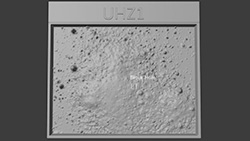CXC Home | Search | Help | Image Use Policy | Latest Images | Privacy | Accessibility | Glossary | Q&A
1
X-ray & Infrared Images of UHZ1Credit: X-ray: NASA/CXC/SAO/Ákos Bogdán; Infrared: NASA/ESA/CSA/STScI; Image Processing: NASA/CXC/SAO/L. Frattare & K. Arcand
Astronomers found the most distant black hole ever detected in X-rays (in a galaxy dubbed UHZ1) using the Chandra and Webb space telescopes. X-ray emission is a telltale signature of a growing supermassive black hole. This result may explain how some of the first supermassive black holes in the universe formed. These images show the galaxy cluster Abell 2744 that UHZ1 is located behind, in X-rays from Chandra and infrared data from Webb, as well as close-ups of the black hole host galaxy UHZ1.
2
Illustration: Formation of a Heavy Seed Black Hole from Direct Collapse of a Massive Cloud of GasCredit: NASA/STScI/Leah Hustak
This set of illustrations explains how a large black hole can form from the direct collapse of a massive cloud of gas a few hundred million years after the big bang. Panel #1 shows a massive gas cloud and a galaxy moving towards each other. If the formation of stars in the gas cloud is stalled by radiation from the incoming galaxy - preventing it from forming a new galaxy — the gas can instead be driven to collapse and form a disk and black hole. Panels #2 and #3 show the beginning of this gas collapse in the center of the cloud. A small black hole forms in the center of the disk (panel #4) and the black hole and disk then continue to grow (panel #5). This massive black hole "seed" and its disk then merge with the galaxy shown in panel #1. For a period the black hole is unusually massive compared to the mass of the stars in the galaxy, making it an Outsize Black Hole (panel #6). Stars and gas from the galaxy are pulled in by the black hole, causing the black hole and disk to grow even larger.
3
3D Printable Files: UHZ1(3D Print Credit: NASA/CXC/A. Jubett, using software by Tactile Universe/N. Bonne & C. Krawczyk & Blender)
The tactile plate of UHZ1 behind Abell 2744 features a physical relief map based on the intensity of X-ray and infrared data, depicting a black hole in an early stage of its development, just 470 million years after the Big Bang.
The plate shows data from NASA’s Chandra X-ray Observatory and James Webb Space Telescope. It features scores of seemingly tiny celestial objects. This is the galaxy cluster Abell 2744. These tiny celestial objects are spiral and elliptical galaxies, and gleaming stars. Many of these specks appear to float in a raised, bumpy cloud of X-ray gas in the center of the image, some 3.5 billion light-years from Earth.
Just to the right of center, at the edge of the raised gas cloud, is a tiny speck. This speck is far in the distance, well beyond the Abell galaxy cluster, and difficult to discern from the rest of the data, so we have added a raised box to show its location. It represents a galaxy 13.2 billion light-years from Earth containing a supermassive black hole.
The plate shows data from NASA’s Chandra X-ray Observatory and James Webb Space Telescope. It features scores of seemingly tiny celestial objects. This is the galaxy cluster Abell 2744. These tiny celestial objects are spiral and elliptical galaxies, and gleaming stars. Many of these specks appear to float in a raised, bumpy cloud of X-ray gas in the center of the image, some 3.5 billion light-years from Earth.
Just to the right of center, at the edge of the raised gas cloud, is a tiny speck. This speck is far in the distance, well beyond the Abell galaxy cluster, and difficult to discern from the rest of the data, so we have added a raised box to show its location. It represents a galaxy 13.2 billion light-years from Earth containing a supermassive black hole.
Return to: NASA Telescopes Discover Record-Breaking Black Hole (November 6, 2023)












